‘We are old, Chevalley, very old. For at least twenty-five centuries we have carried on our backs the weight of magnificent and heterogeneous civilisations; all came from the outside already perfect and complete; none did we ourselves conceive; for none did we set the tone. We are as white as you are, Chevalley, as white as the queen of England, and yet for two thousand five hundred years we have been a colony.’ The words of Don Fabrizio, ‘The Leopard’ of Giuseppe Tomasi di Lampedusa’s novel, to a representative of the new colonial power, united Italy, are brought to mind by ‘Sicily: Culture and Conquest’ now at the British Museum (until 14 August) and by the Ashmolean’s ‘Storms, War and Shipwrecks: Treasures from the Sicilian Seas’ (21 June–25 September).
Of Don Fabrizio’s succession of foreign civilisations two are explored at the British Museum in depth – the Greek and the Norman. Only the Greek could be said to have arrived ‘already perfect and complete’. The Normans, who boasted of their descent from pirates, initially brought to Sicily not civilisation, but destruction. In the preamble to Greek charters issued in 1093, the year after he completed the conquest of Muslim Sicily, Roger, the first Norman count of the island, expressed his dismay: ‘Who, seeing the huge and widespread ruin of the castles and cities of the Muslims, and observing the vast destruction of their palaces, built with such great skill […] would not consider this to be a great and manifold disaster and an incalculable loss.’ Today, not a single structure built under Muslim rule survives above ground and, excepting coins and potsherds, the surviving objets d’art made in Islamic Sicily can be counted on the fingers of one hand.
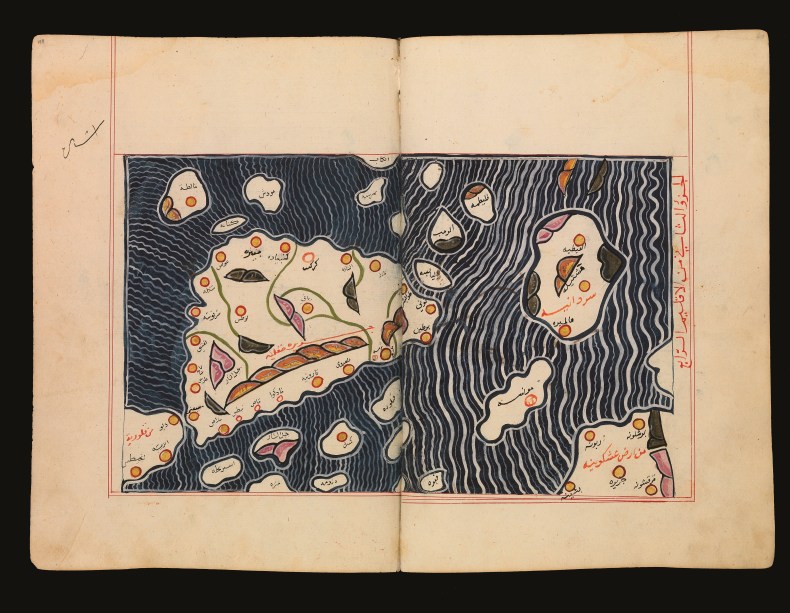
A double-page map of Sicily from Al-Idrisi’s Treatise, c.1300–1500 AD. © The Bodleian Libraries, University of Oxford
Not all the damage was done by Roger’s knights. Byzantine Sicily was invaded by Arab and Berber troops from North Africa during the 9th century. For the first hundred years, Muslim Sicily served as a base for the jihad against Byzantine outposts in the east of the island and on the mainland. In 969–73, when the Fatimid caliphs moved east to Cairo, they left Sicily to the Kalbid Arabs. Palermo flourished under Kalbid rule, but little survives from its brief efflorescence, and the Qur’an copied in Palermo in 982/83 is almost the only important relic of Muslim Sicily. In the 1020s, the emirate was torn apart by civil war. As rival warlords struggled for superiority, the surrounding Christian powers seized the opportunity to invade. In 1038–42, a Byzantine expedition nearly succeeded in conquering the island. It included a large contingent of Norman mercenaries led by the two eldest of 12 brothers who were to leave the village of Hauteville on the Cotentin Peninsula to seek their fortunes in southern Italy. In 1060, the two youngest de Hauteville brothers, Robert Guiscard and Roger, crossed the Straits of Messina as mercenaries employed by a Muslim warlord. On his death in 1062, they began the conquest of Sicily for themselves.
The devastation lamented by Count Roger in 1093 was thus caused by more than 60 years, two generations, of civil war and invasion. Small wonder that Roger chose to spend little time on the island and made his capital at Mileto in Calabria. In Sicily, little was built except fortifications and the first abbeys and cathedrals of the Latin church, colonial outposts whose architecture harked back to Normandy. After Roger I died, his widow, Adelaide, fought to secure the rights of his infant heir. When Roger II finally came of age, he had to spend the next 20 years on the mainland struggling to consolidate his inheritance. Only after Christmas Day 1130, when Roger had himself crowned first king of Sicily, did he begin to build his island kingdom.
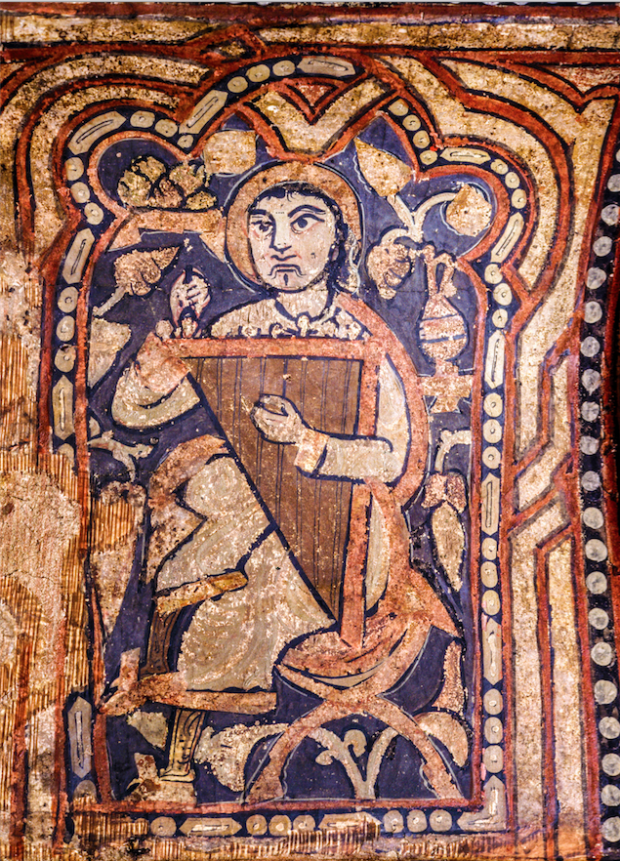
Panel showing King David tuning a triangular psaltery on the ceiling of the nave of the Cappella Palatina in the Palazzo dei Normani, Palermo, constructed in the 1140s. Photo: taken under the direction of Robert Hillenbrand, Khalili Research Centre; © Barakat Trust and University of Edinburgh
The art and architecture of the Norman monarchy is celebrated for the combination of elements from Byzantine, Islamic, and Romanesque art. The Cappella Palatina in Roger’s principal palace in Palermo juxtaposed an audience hall, adorned with Arabic inscriptions and covered by a painted wooden ceiling made by Muslim craftsmen, with a vaulted chapel, decorated with Byzantine mosaics of the life of Christ and furnished with Greek inscriptions. Both Byzantine mosaicists and Muslim painters were ordered to incorporate Latin elements into their repertoire. The mosaic of the Pentecost shows the Holy Spirit as a dove issuing directly from the Son, a diagrammatic representation of the Filoque clause – the notorious addition to the Nicene Creed expressing the Latin understanding of the Trinity that was a principal cause of the 11th-century schism between Rome and Constantinople. To the painted chorus of dancing-girls and musicians, who might have graced the hall of almost any Muslim ruler, is added a single image of the archetypal Old Testament king, David, tuning his psaltery according to an iconographic formula borrowed from a Romanesque manuscript.
The Norman king was most commonly depicted in the robes of a Byzantine emperor, and that image circulated widely through the mass media of coins and seal impressions. In the painted ceiling of the royal hall in Palermo, he was represented in the garb and classic pose of a Muslim ruler. Below, the Arabic verse inscriptions around his throne urged courtiers to worship his palace with the same rites that a Muslim pilgrim performs at the Ka‘ba in Mecca. In the British Museum, a pair of images of the king can be seen in the backlit photograph of the ceiling, suspended above the visitors’ heads. In a case nearby, a fragment of the inscription from Roger’s throne stands out as bold and fresh as ever. The coins, documents, and inscriptions of the Norman kings of Sicily used the Arabic, Greek, and Latin languages. Looking back at that golden age, Peter of Eboli called Palermo ‘a once-happy city, blessed with a three-tongued people’.
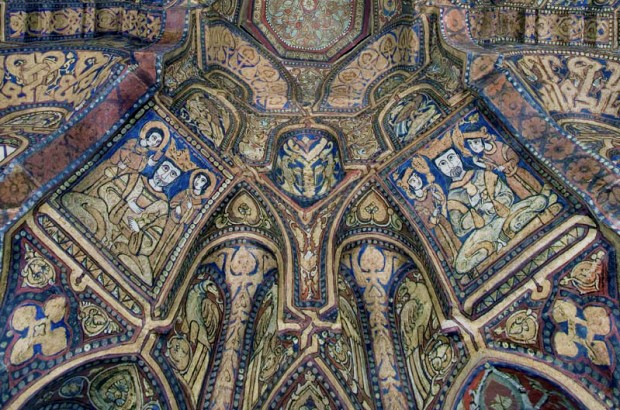
A pair of Norman rulers in the garb and pose of a Muslim ruler, each flanked by two attendants, in the muqarnas zone of the Cappella Palatina, Palazzo dei Normanni, Palermo, which was constructed in the 1140s. © Jeremy Johns
Such multiculturalism in Norman Sicily has long excited the popular imagination. Edward Gibbon, mistaking Roger I for his son, praised his ‘liberal and enlightened mind, above the limits of his age and education’. Charlie Homer Haskins, the leading scholar of the 12th-century renaissance, thought it ‘not too much to call the kingdom of Roger and his successors the first modern state’ for its ‘policy of toleration and assimilation’. ‘Sicily: Culture and Conquest’ takes a more judicious view, stressing that the Norman kings compelled their privileged Latin subjects to live peacefully alongside second-class communities of Muslims, Jews and Greek Christians, so that ‘the island became a place of tolerance and coexistence, but not of integration or equality’.
Before Sicily was conquered by the Normans, its rulers had been first Byzantine and then Muslim. It is therefore tempting to assume that the Byzantine and Islamic elements in Norman art and architecture were indigenous to Sicily and contributed by her subject peoples. A moment’s reflection shows that to be false. Everything Latin was newly imported. The mosaics and other Byzantine elements follow contemporary Constantinopolitan fashion. As to the Islamic component, there was no court, no royal patron in Sicily during the century that separated the fall of the Kalbid emirate from Roger’s coronation, so that the new king and his ministers were presented with almost a tabula rasa. Few aspects of material culture exhibit any degree of continuity over that period. The only significant exceptions – coins, documents, and inscriptions that use Arabic – were all radically reformed after 1130 on models imported from contemporary Egypt and North Africa.
Nor was royal multiculturalism the spontaneous product of the proximity of Arab, Greek, and Latin cultures in Norman Sicily. It was rather carefully assembled by royal ministers from the work of artists, craftsmen, and scholars brought from outside the island – mosaicists from Constantinople; carpenters and painters from Fatimid Cairo; ecclesiastical architects, masons and stone-carvers from Campania and Apulia, southern France and the Anglo-Norman world; palace architects and masons from Egypt and North Africa; silk-weavers kidnapped from Corinth and Thebes; Latin notaries from Rome, Montecassino and northwest Europe; Greek logothetes and scribes trained in the monastic scriptoriums of eastern Sicily and Calabria; Arabic secretaries from Cairo and al-Mahdiya; and many more besides.
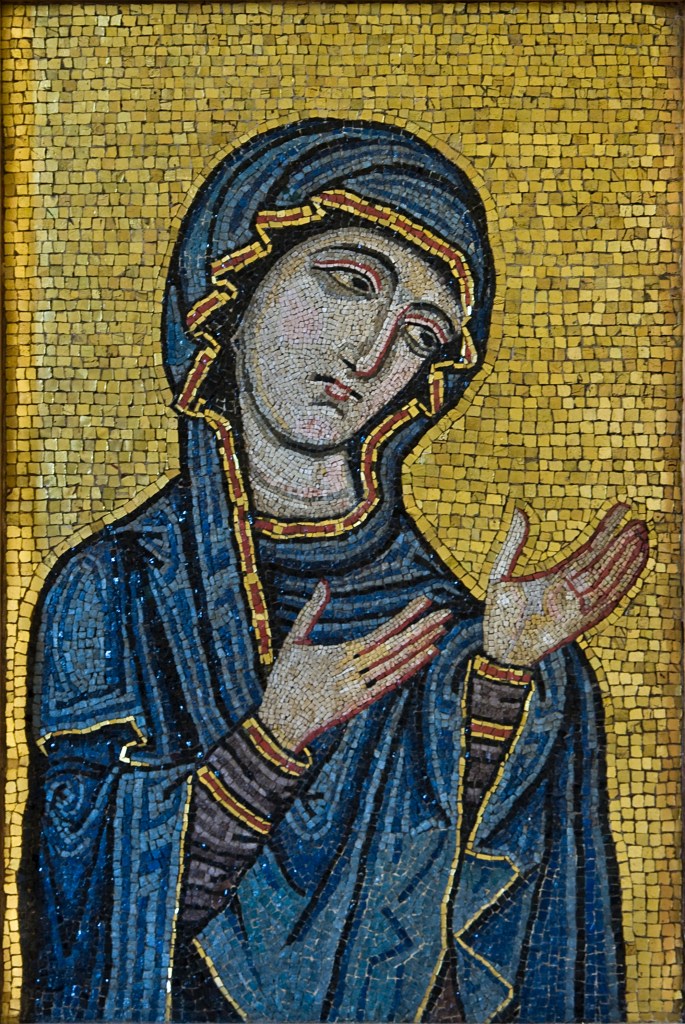
Byzantine-style mosaic showing the Virgin as Advocate for the Human Race, originally in Palermo Cathedral, c. 1130–80 AD. Museo Diocesano di Palermo
One such immigrant, George of Antioch, played a crucial role as an architect of the new monarchy. George’s family were Armenians who had served first the Byzantine emperor in the Levant and then the Zirid emir of North Africa. After George defected to Norman Sicily, he was dispatched many times as ambassador to Fatimid Cairo. Byzantine Constantinople attempted to suborn him with honours and imperial titles. He was intimately connected to elites in Cairo, Constantinople and Jerusalem through the influential Armenian diaspora. George had all the inside knowledge of the royal courts and palaces of the Mediterranean that his parvenu Norman master lacked. In 1126, four years before his coronation, George was appointed Roger’s chief minister, his vizier, his ‘emir of emirs’, the office that he held until 1151, just three years before Roger’s death. According to one Arabic source, George was the king-maker, who ‘veiled Roger from his subjects and arranged for him to dress in clothes like the Muslims […] he acquainted Roger with the lives of kings […] [so that] Roger’s state grew under his management.’
George reformed the Norman administration and created the trilingual royal chancery that became one of the most potent symbols of Norman multiculturalism. In the early 1130s, he began to build his own church in Palermo, popularly known as the Martorana, but correctly called Santa Maria dell’Ammiraglio – St Mary’s ‘of the Emir’. This was the earliest of the Sicilian churches to be decorated in the style of the Cappella Palatina, Cefalù, and Monreale, the great royal churches with Byzantine mosaics, opus sectile pavements, extravagant use of porphyry, inscriptions in Arabic and Greek, wooden doors and fittings carved in the Fatimid style, stained glass in plaster window grilles with Arabic inscriptions, stonework with ablaq inlaid decoration, and painted wooden panels. In St Mary’s, George’s mosaicists experimented with many of the ideas about the nature of the new monarchy that were later to be perfected in the Cappella Palatina. For the narthex, he commissioned two mosaic panels: in one, with George prostrated at her feet, the Virgin holds her Greek petition urging Christ to protect George and his family and to pardon their sins; in the other, Christ clutches his mother’s petition on behalf of George, and places the royal diadem directly upon the head of Roger who wears Byzantine imperial robes. As a pair, the two panels celebrate George’s role in the construction of the monarchy. But the king’s panel also makes the earliest and most explicit visual statement of two fundamental claims of the Norman monarchy, constantly thereafter repeated in the art and architecture of the kingdom: christomemesis, the idea that the earthly king imitates the king of heaven; and caesaropapism, the assertion that the king possessed supreme authority over both church and state, without the intervention of the Pope of Rome.
George’s experiments in St Mary’s allow us to glimpse the first stages in the construction of the royal image in Norman Sicily. The mosaic art through which these ideas are expressed was reintroduced from contemporary Constantinople. The ideas themselves owed more to Byzantium, Cilician Armenia, and to Roger’s court than to Rome and Latin Europe. Almost nothing in Roger’s new monarchy was derived from Sicily’s Greek or Roman past. Roger’s biographer, Alexander of Telese, toyed with the idea that Palermo ‘had once, in ancient times, had kings’. But Roger, who had won his kingdom by force and been crowned by Christ himself, had little need of history to legitimate his kingship; unlike his enemies, the Pope and the German Emperor, who had their propagandists claim that the pagan tyrants of Greek Sicily were the true ancestors of the Norman rex tyrannus.
The Norman objects and images in this exhibition were produced within the narrow circle of the royal court. So powerful and enduring are the buildings and objects created for Roger that it is easy to misread them as advocating equal respect for the cultures of his kingdom. But the appropriation of a variety of cultures, and the display of their exotic symbols, was intended above all to demonstrate the universal extent and power of the king’s authority. This was yet another idea borrowed from Constantinople, and is most clearly enunciated in a Greek panegyric by Eugenios, a minister of the later Norman kings: ‘Do you [the king] not harmonise the inharmonious, and mix together the unmixable […] with wise foresight blending and uniting into a single race disparate and incongruent peoples?’ Norman multiculturalism was the exhibition of royal power.
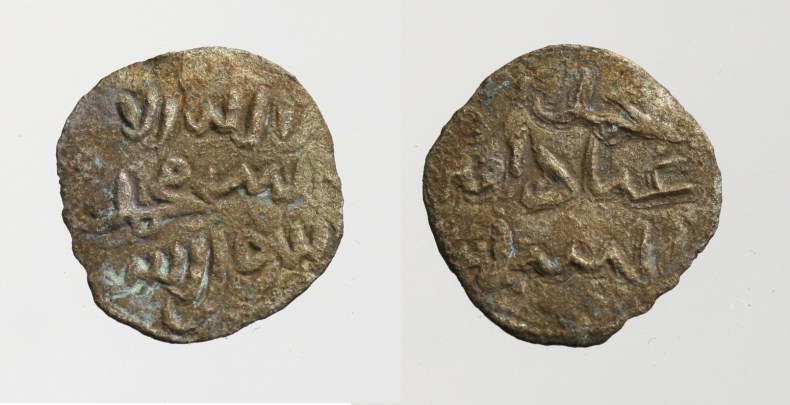
A fraction of a dirham struck in the name of Muhammed ibn ‘Abbad, the rebel ’emir of the Muslims’, early 13th century. Ashmolean Museum, Oxford; © Jeremy Johns
From the outset, local Sicilian craftsmen participated as assistants and labourers in the creation of the royal image, and gradually learned the ideas and techniques introduced by their foreign masters. By the 1170s and ’80s, in William II’s great church and palace complex at Monreale, forms and motifs first imported under King Roger are ‘distilled, refined and blended so that they cannot be separated’. Had William not died childless while Monreale was still under construction, plunging the island into a century of civil war, rebellion and foreign invasion, it is just possible that royal multiculturalism might have spread beyond the court. But the steady influx of land-hungry immigrants from the Italian mainland kept up the pressure upon the indigenous Greek Christians and Muslims, who were protected only by royal authority. When that failed on William’s death in November 1189, the Latin Christians began to massacre the Muslims, even in the royal palace in Palermo, and the Muslims were forced into open rebellion.
When the German emperor, Henry VI, who had married King Roger’s daughter, Constance, conquered Sicily in 1194, he set about dismantling his father-in-law’s multicultural monarchy. German knights replaced Greeks and Muslims as royal ministers; Arabic and Greek were abandoned and Latin became the sole administrative language. Henry died young, and his widow, Roger’s daughter, began to recreate the trilingual chancery by importing scribes from Almohad Spain to replace those recently massacred. But this revival was short-lived. Constance herself died only a year after her husband, leaving Pope Innocent III and Henry’s German ministers to fight for control of Frederick, her four-year old son. In Sicily, civil war and rebellion rumbled on. Much later, in the early 1220s and mid 1240s, Frederick used a combination of military campaigns, mass conversion, ethnic cleansing, expulsion and transportation to suppress the Muslim rebels. At the same time, paradoxically, he attempted to revive his grandfather’s trilingual administration, and again issued royal documents in Arabic, Greek and Latin. But Frederick was unable to rebuild Roger’s multicultural monarchy and soon gave up the attempt. Like his great-grandfather, Frederick preferred to dwell on the mainland, in Apulia, and spent relatively little time in Sicily.
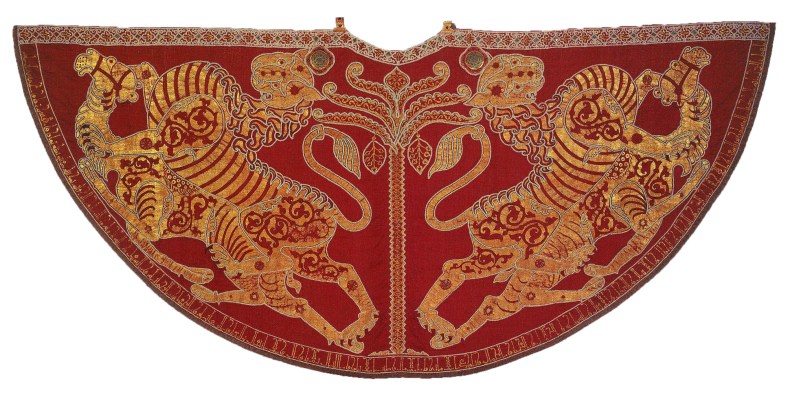
Mantle of Roger II, 1133/34. Kaiserliche Schatzkammer, Kunsthistorisches Museum, Vienna
The churches and palaces built by the Norman kings are the most effective publicists of Sicilian multiculturalism, but could not be brought to London. Also missing is the Norman regalia carried off to Germany by either Henry VI or the young Frederick II, and now confined in the Austro-Hungarian imperial Schatzkammer in Vienna. The mantle made for King Roger in Palermo in 1133/34 is a monumental construction of gold, pearls, and red samite; a few scraps of original lining, and a printed reproduction that looks like a souvenir tea-towel, wholly fail to convey the sheer physicality of the original, which weighs a knee-trembling 50 kilograms. Despite absentees, ‘Sicily: Culture and Conquest’ manages to assemble a dazzling assortment of treasures from King Roger’s multicultural monarchy, the peak of artistic achievement in medieval Sicily. Few objects survive from the troughs, and the absences and gaps are left to speak for themselves: almost nothing from the Kalbid emirate and its anarchic coda; nor from the 30 years of Norman conquest and the first generation of Norman rule; nor from the relentless destruction of multicultural Sicily during the century between the death of William II and the Sicilian Vespers. But those troughs must be plumbed in order to understand that King Roger’s multicultural art and architecture was no liberal experiment before its time in toleration and assimilation. It was rather a carefully engineered claim to universal dominion, enunciated in Arabic, Greek, and Latin, in gold, pearls, porphyry, and silk, on behalf of a parvenu king, whose father had been raised on the muddy Cotentin Peninsula in a castle built of timber and turf.
‘Sicily: Culture and Conquest’ is at the British Museum, London, until 14 August.
‘Storms, Wars and Shipwrecks’ is at the Ashmolean Museum, Oxford, from 21 June–25 September.
From the June issue of Apollo: preview and subscribe here.
Unlimited access from just $16 every 3 months
Subscribe to get unlimited and exclusive access to the top art stories, interviews and exhibition reviews.

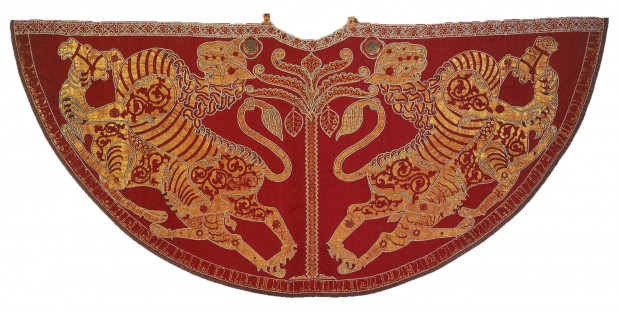
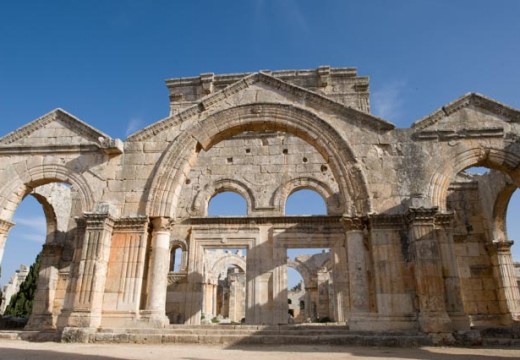
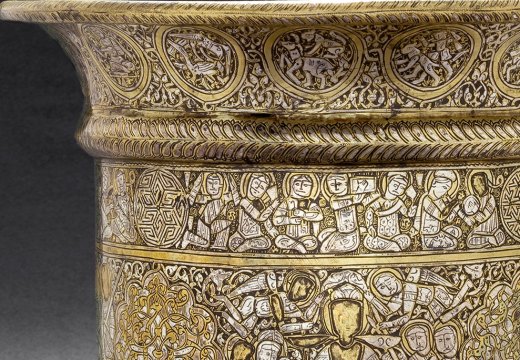
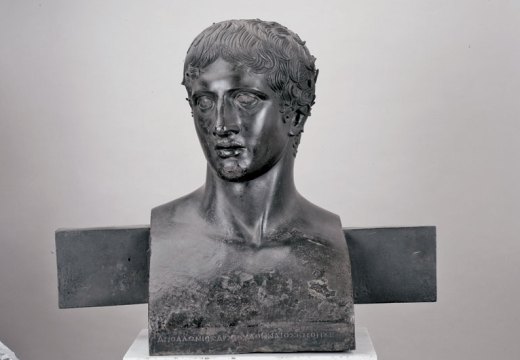









![Masterpiece [Re]discovery 2022. Photo: Ben Fisher Photography, courtesy of Masterpiece London](http://www.apollo-magazine.com/wp-content/uploads/2022/07/MPL2022_4263.jpg)
Why are fathers so absent from art history?